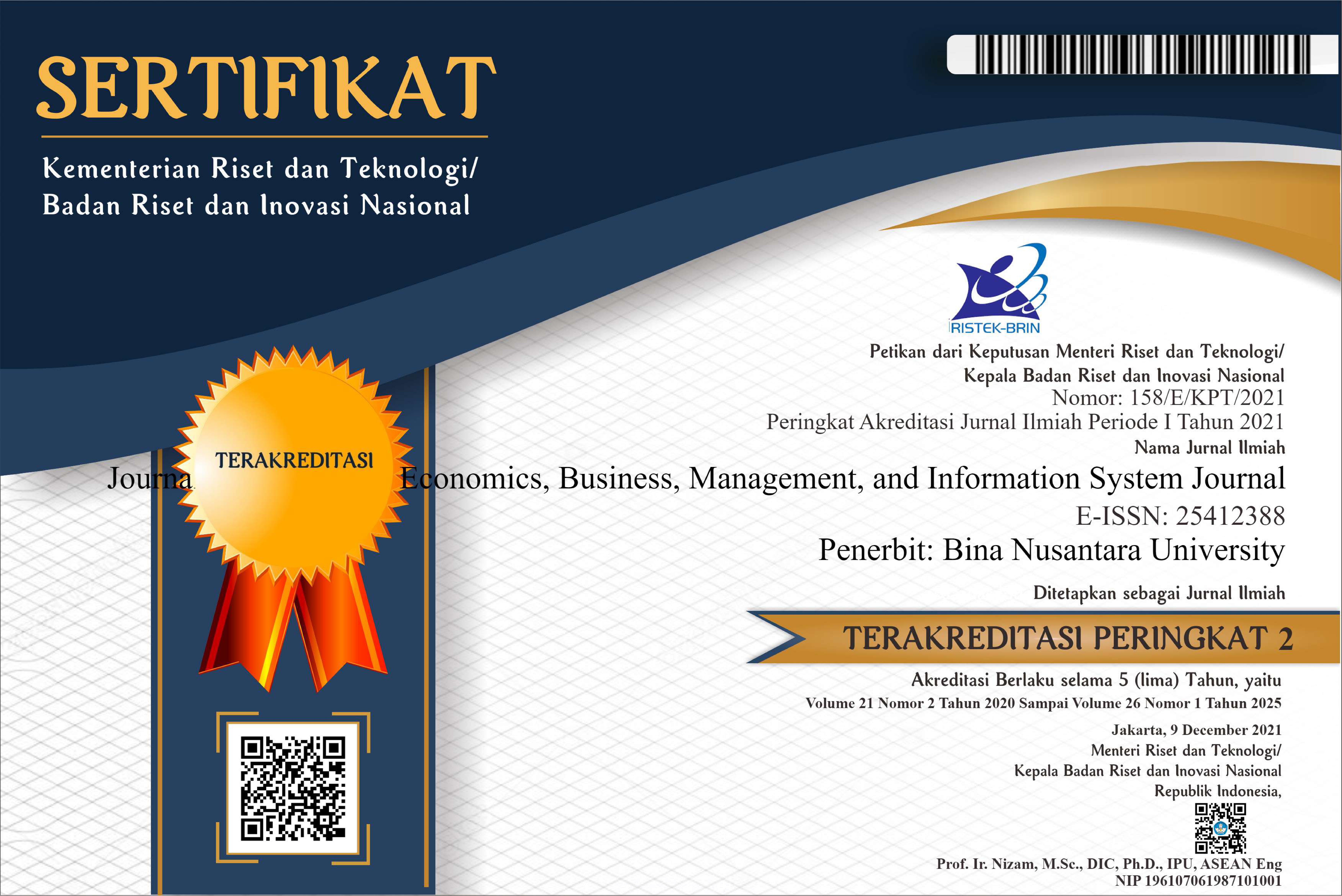Segmentation Map, Consumer Preference, and Price Determination Appropriate for Wedding Organizer Business in Jakarta
DOI:
https://doi.org/10.21512/tw.v19i2.4418Keywords:
behavioral segmentation, demographic segmentation, consumer preference, pricing perception, wedding organizerAbstract
This research was aimed to validate segmentation from previous research, determining consumer preference and pricing perception based on preferences selected by the Wedding Organizer (WO) consumer in each validated segment to reach consumer satisfaction. This research was a quantitative descriptive research by using probability sampling with 100 total respondents. The used analytical models, were differences in accordance to each problem studied, those were; (1) segmentation was analyzed by cluster analysis and cross tabulation and, (2) consumer preference, as well as pricing perception, were analyzed by cross tabulation. This research produces three segmentations of wedding organizer users and their appropriate product and service preference, including price perception from each of the consumers. In terms of fair price, each segment has their own perception. Smart couple prefers standard portfolio in product and office performance, employee quality and service contract in service, priced in 65 Mio – 125 Mio. Uncle Scrooge prefer catering, rundown management and makeup & wardrobe in product and employee quality in service, all in the price range of 65 Mio – 125 Mio. Familiar face couple has catering in product preference and consultant allocation in service preference, all in the price range of 65 Mio – 125 Mio.
Plum Analytics
References
Alhassan, F., & Sakara, A. (2014). Factors influencing market segmentation in the hotel industry. International Journal of Economics, Commerce and Management, 2(9), 1-16.
Butler, K., Gordon, R., Roggeveen, K., Waitt, G., & Cooper, P. (2016). Social marketing and value in behavior? Perceived value of using energy efficiently among low income older citizens. Journal of Social Marketing, 6(2), 144-168.
Cermak, D. S., File, K. M., & Prince, R. A. (1994). A benefit segmentation of the major donor market. Journal of Business Research, 29(2), 121-130.
Cravens, D. W., & Piercy, N. F. (2013). Strategic Marketing (10th Ed.). New York: Mcgraw-Hill International.
Etzel, M. J., Bruce J. W., & Stanton, W. J. (2001). Marketing (12th Ed.). New York: CAB International.
Kotler, P., & Armstrong, G. (2012). Principle of marketing 14th Ed. New Jersey, USA: Pearson Prentice Hall.
Kotler, P., Bowen, J. T., & Makens, J. C. (2005). Marketing for Hospitality and Tourism (4th Ed). New Jersey: Pearson Education.
Mansur, A. (2016). Bisnis wedding organizer sangat prospektif. Retrieved February 10th, 2017 from http://www.neraca.co.id/article/63399/bisnis-wedding-organizer-sangat-prospektif.
Melati. (2015). Apa saja yang menjadi pertimbangan penting bagi calon pasangan pengantin dalam memilih wedding organizer. Retrieved February 14, 2017 from http://sbm.binus.ac.id/2015/05/27/apa-saja-yang-menjadi-pertimbangan-penting-bagi-calonpasangan-pengantin-dalam-memilih-sebuah-wedding-organizer.
Middleton, V. C. T., & Clarke, J. (2008). Marketing in travel and tourism. Journal of Travel Research, 27(3), 49-49.
Musyoka, S. M., Mutyauvyu, S. M., Kiema, J. B. K., Karanja, F. N., & Siriba, D. N. (2007). Market segmentation using geographic information systems. Marketing Intelligence & Planning, 25(6), 632-642.
Myers, C. S. (1996). Trust, commitment and values shared in long-term relationships in the services marketing industry. Master’s Thesis. Las Vegas: University of Nevada.
Sitorus, R. (2016). Peluang untung dari binsis wedding organizer. Retrieved February 10th, 2017 from http://entrepreneur.bisnis.com/read/20160129/263/514402/peluang-untung-dari-bisniswedding-organizer.
Srihadi, T. F., Hartoyo., Sukandar, D., & Soehadi, A. W. (2016). Segmentation of the tourism market for Jakarta: Classification of foreign visitors’ lifestyle typologies. Tourism Management Perspectives, 19, 32-39.
Suki, N. M. (2013). Students’ demand for smartphones: Structural relationships of product features, brand name, product price and social influence. Campus-Wide Information Systems, 30(4), 236-248. https://doi.org/10.1108/CWIS-03-2013-0013.
Swani, K., & Yoo, B. H. (2010). Interactions between price and price deal. Journal of Product and Brand Management, 19(2), 143-152.
Sweeney, J. C., & Soutar, G.N. (2001). Consumer perceived value: The development of a multiple item scale. Journal of Retailing, 2(77), 203-220.
Tjiptono, F., & Chandra, G. (2005). Service, quality, and satisfaction. Yogyakarta: ANDI.
Widiyanto, I. (2008). Pointers: Metodologi penelitian. Semarang: BP Universitas Diponegoro.
Downloads
Published
Issue
Section
License
Authors who publish with this journal agree to the following terms:
a. Authors retain copyright and grant the journal right of first publication with the work simultaneously licensed under a Creative Commons Attribution License - Share Alike that allows others to share the work with an acknowledgment of the work's authorship and initial publication in this journal.
b. Authors are able to enter into separate, additional contractual arrangements for the non-exclusive distribution of the journal's published version of the work (e.g., post it to an institutional repository or publish it in a book), with an acknowledgment of its initial publication in this journal.
c. Authors are permitted and encouraged to post their work online (e.g., in institutional repositories or on their website) prior to and during the submission process, as it can lead to productive exchanges, as well as earlier and greater citation of published work.
USER RIGHTS
All articles published Open Access will be immediately and permanently free for everyone to read and download. We are continuously working with our author communities to select the best choice of license options, currently being defined for this journal as follows: Creative Commons Attribution-Share Alike (CC BY-SA)

















